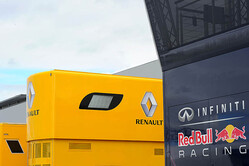 Remi Taffin, Renault Sport F1 head of track operations: It's fair to say that Spa is the hardest circuit of the year for the Power Units. There are long periods of wide open throttle, sweeping, high speed corners, hard stops and several important changes of altitude. Any one of these factors would be taxing for the new units, but the combination over one awesome 7km lap is enough to make even the hardiest engineer nervous.
Remi Taffin, Renault Sport F1 head of track operations: It's fair to say that Spa is the hardest circuit of the year for the Power Units. There are long periods of wide open throttle, sweeping, high speed corners, hard stops and several important changes of altitude. Any one of these factors would be taxing for the new units, but the combination over one awesome 7km lap is enough to make even the hardiest engineer nervous.
The lap proper starts on the climb from La Source to Les Combes. The driver will put his foot firmly on the throttle and will not lift for around 25secs until he reaches the top of the hill at Les Combes. It's the longest period of wide open throttle on the calendar, more than 20 times the length of a soccer pitch, and the ICE will be stressed to its absolute maximum at this point. But it's not just the length of this straight, it's also the changes in altitude that will load the internals both laterally and vertically. At the highest point the circuit rises to more than 600m and the turbo will be rotating at close to its limit; over 100,000rpm or almost 2,000 revs per second! We've had the experience of this relatively high altitude in Austria and can afford to be a bit more aggressive here so rotational speeds could be even higher.
After the braking point for Les Combes the driver will go into sector two, which switches the onus to the ERS and energy recovery. The MGU-H will continue to recover energy through the high-speed flowing corners such as Pouhon and Fagnes, and will feed this to the MGU-K and ICE on the next period of throttle through Blanchimont.
The best opportunity for the MGU-K will be the Bus Stop chicane, which the driver approaches at over 300kph and brakes down to just 75kph. The lap is long, and fuel consumption correspondingly high, so these opportunities are manna from heaven to bring everything down into the 100kg allowed limit for the race. We may also practice overloading the ICE to further increase electrical power. This is where we inject slightly more fuel than necessary into the ICE to produce more overall power, which in turn allows the MGU-K and MGU-H to recover more energy to recharge the battery.
While we know that Spa will be a big test for the Power Unit, we know the circuit well and our preparations have been thorough. We'll go there ready to attack and take advantage of any opportunity.
Belgium in numbers - with 1 being the easiest, 5 being the most severe
Internal Combustion Engine: 5
MGU-K: 5
MGU-H: 5
Battery: 4
Fuel Consumption: 4
Energy Recovery: 5
F1-2014 Fast Facts:
70% of the 7km track is spent flat out, equating to almost 5.5km, or the length of a standard F1 circuit. Over one lap the engine will have a total wide open throttle time of over 75secs, making it an incredible test for Power Units.
At the end of the old pits the track starts to climb very sharply, with a gradient close to 1 in 4, equivalent to one of the steepest climbs in the Tour de France. This is particularly tough for the ICE as loads suddenly change. Going over the crest of the hill, they will change even more dramatically, with the vertical force suddenly lifted and the parts unloaded, with the vertical forces switching to -3g. This can affect fluid flow through the lubricant and fuel systems as they too ‘rise' within the system and away from their respective pumps – the systems therefore need to be ultra-effective to avoid starvation.
Weather is always a factor in Spa, but the potential for heavy rain could have surprising implications on the Power Units. If water enters, the high volume of electrical systems in the PU could short out. F1 cars are now equipped with military spec wiring but special care will be taken to insulate the systems against the humidity, with ducts fitted to divert rain away from the systems.
The Renault turbo made its Spa debut in 1978. The challenges of Spa have always caused a race of attrition and it took until 1980 for Rene Arnoux to score Renault's first finish. Alain Prost won from pole position in 1983 with Derek Warwick second in 1984. Ayrton Senna (Lotus-Renault) took the win in 1985 and came second in 1986. In the normally aspirated era, Damon Hill (Williams) and Michael Schumacher (Benetton) gave Renault consecutive wins from 1993 to 1995 before Sebastian Vettel took wins for Red Bull in 2011 and 2013.






















sign in